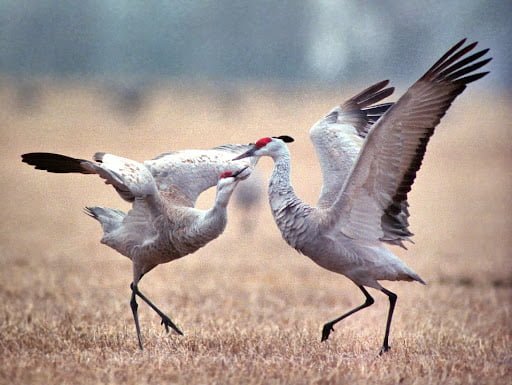
Springtime is many people’s idea of the perfect season. The days are getting warmer and my favorite, longer, and flowers are thinking of showing off their beautiful colors. Actually, fall is my favorite season but spring brings wonderful memories of the spring migration of many species of birds. Especially the Lesser Sandhill cranes that fly through the Central Flyway zone right down the middle of the country.
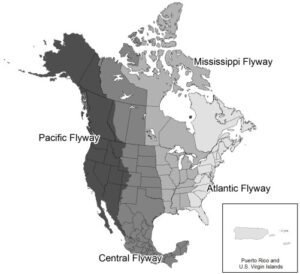 Every year the sandhill cranes start a spectacular journey from their wintering grounds in Mexico and Texas to clear up in Alaska, Canada and even Siberia to settle down and start a family. This is a 5000-mile trip one way as the crane flies so to speak. They have to make a stopover to refuel and rest and maybe fall in love and find a mate in Nebraska.
Every year the sandhill cranes start a spectacular journey from their wintering grounds in Mexico and Texas to clear up in Alaska, Canada and even Siberia to settle down and start a family. This is a 5000-mile trip one way as the crane flies so to speak. They have to make a stopover to refuel and rest and maybe fall in love and find a mate in Nebraska.
80% of the entire population will stop for around 4 to 6 weeks on the Platte river in Nebraska. Some will arrive early around late January to early February and others will wait until late February early March. The Sandhills have been doing this journey for thousands of years. They are one of the oldest species of birds in the world. Scientists have found fossils that date back 2.5 million years.
If you don’t know what one looks like, they are a tall elegant gray bird that stands around 4-feet tall and weighs 6 to 8 lbs with a 6-foot wingspan and a bright red patch of skin on their head. Now you may be wondering why the bird in the picture below is brown? Well, I will tell you. When the birds stick their beaks in iron-rich soil and preen their feathers they get stained brown. It is good camouflage when on the nest. They will socialize on the river but on the breeding ground no other birds are allowed around the breeding pair. When they molt they will go back to their beautiful gray selves until the next dye job.
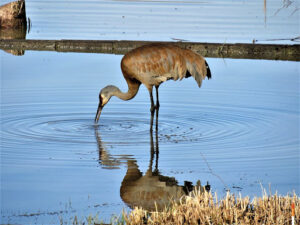
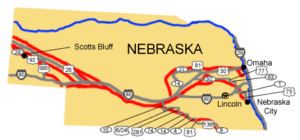 Without this stopover on the Platte they would not survive the trip to the breeding ground. Before humans unnaturally redesigned the river with dams and irrigation and just plain water usage, the cranes had the whole river (200 miles) from border to border of Nebraska to stop and refuel now it has been reduced to maybe a 50-mile section. This shoves a lot of birds in a very small area because the birds need to roost in the water for survival against predators. No tree roosting for this bird. They don’t have the feet for it. Their toes can’t grasp a branch.
Without this stopover on the Platte they would not survive the trip to the breeding ground. Before humans unnaturally redesigned the river with dams and irrigation and just plain water usage, the cranes had the whole river (200 miles) from border to border of Nebraska to stop and refuel now it has been reduced to maybe a 50-mile section. This shoves a lot of birds in a very small area because the birds need to roost in the water for survival against predators. No tree roosting for this bird. They don’t have the feet for it. Their toes can’t grasp a branch.
But the river needs to meet certain criteria for the cranes to be happy. The water can only be shallow, maybe a foot at most, so the birds can stand in it, not float like a duck. These birds stand in water all night during frigid temperatures. And how do they do that you’re thinking? If humans did that we would lose our feet to frostbite or our lives to hypothermia.
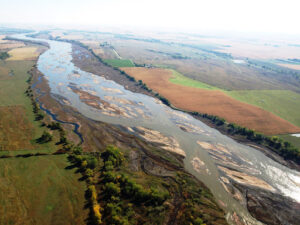
For cranes, only enough blood goes into the foot to keep the tissues functional then you put the vein with cold blood snuggled up to the artery with warm blood so the blood can be warmed before it gets to the core of the bird. Is that cool or what? These birds were designed for frigid weather. The river needs to be clean of vegetation so predators can’t sneak up on them. So we need clean sandbars and with the river running the way it is, with no flooding to clear off the vegetation, humans have to do it with tractors and graders.
That is where the hard working people of the Lillian Annette Rowe Sanctuary and the Crane Foundation come in. Both of these sanctuaries are located right on the river and are there to help the cranes even when the cranes have moved on. To help pay for all this work both sanctuaries run guided tours to bird blinds during the migration. A morning or evening tour is an option with reservations or just sit in your car during the day and watch them eat in the fields. The corn the farmers leave in their fields are a great food source for the birds along with invertebrates. Cranes have evolved to eat this nutrient rich human produced feast. But with the good news comes the bad, without the corn these animals would not have enough food to make it on the last of their journey. Farming practices have gotten much better through the years so the corn left behind is less and less.

Bird Nebraska Crane Nature
The most amazing thing about cranes is that all species of cranes dance and sadly all but the lesser sandhill crane are endangered. Some critically.
On a happier note, did you know that all cranes dance. It is a wonder to watch. They hop in the air with maybe a corn stalk in their beak to dance with. It is a joy to see them seemingly just enjoying the moment and relishing in being alive. Other species besides humans just being silly as it were.
As I said earlier there are guided tours to blinds. I should know I volunteered to give those tours for eight years and they were a wonder every time I did them. Nothing was ever the same. As a guide near exhaustion with all the crane activities that needed to be done. I never took one minute of those tours for granted. Wonderous things happened on every tour.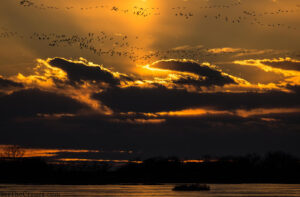
The thing I tell people about these wonderful birds is that when you are in the blind, it is time to come back to nature. For two hours you need to use all your senses and take in everything that those two hours provide. Think about the sound of the river as it flows right next to the blind, that trickling over logs or the muskrat or beaver swimming by. Smell the crispness of the air even if it is a little too crisp. Watch as the sun paints the river water with a pretty pink or golden hue and don’t forget the other wildlife in the area.
On one of my tours a lady was very excited about seeing a particular bird and I thought she might have seen a very rare Whooping crane. No, she had seen a cardinal. We see those all the time, but there weren’t any cardinals where she lived. It was an incredible sighting for her. That showed me that nature is never mundane; never boring. It is a sight, sound and sweet smell for all.
Going to see the cranes is possible for everyone. If you have trouble seeing, the sound is incredible enough to enjoy. The crane call is a work of auditory art. It takes a long trachea to produce that sound and the juveniles actually have a voice change during puberty just like people. Their trachea is much longer than their neck so it wraps around in their chest. If our trachea was as long as a crane’s compared to the length of our neck, we would suffocate. That call can be heard for two and a half miles. But if you don’t hear that well a tour is certainly a feast for the eyes.
If you can’t hike out to the blind they will drive you out in a cart. Don’t ever think you can’t enjoy this spectacle. There is also seating and a porta potty but you have to be very quiet so you don’t spook the birds. The great people at the sanctuaries will do whatever they can to help. But these tours can be pricey, around 50 dollars. The migration season is when these sanctuaries make the money to help these birds year round and covid has hit them hard with tours being very limited or canceled the last couple of years.
I have visited these birds since I was in junior high school and I have never been disappointed. Jane Goodall (famous biologist who studied the chimpanzees in Tanzania in the 60s) travels over 300 days a year. The things that woman has seen and done in her travels are mind blowing and she will tell you that seeing the cranes on the Platte River is one of her favorites. She stops every year now to take in the migration sights and rejuvenate her soul. And if you appreciate nature at all or need your soul cleansed of stressful toxins, take a trip to Nebraska and watch 500 thousand elegant works of exquisite nature in the form of the Lesser Sandhill cranes. I need some detoxing so off north I will go to see some old friends. Maybe I will see you there.


About The Author: Neva
Neva has been a circulation clerk here at the Salina Public Library for three years and has lived in Salina for over 20 years. A northwest Kansas native, she moved to Nebraska to get a BS in Biology with a wildlife emphasis from the University of Nebraska-Kearney. While there she volunteered at the Lillian Rowe Sanctuary during several crane seasons giving tours, helping at the sanctuary and helping with injured birds. She has been a part of the National Audubon for over 20 years with memberships at the different local levels. She still enjoys volunteering time with the local chapter, Smoky Hills Audubon, as vice president and the state chapter, Audubon of Kansas, as a chapter representative board member.
More posts by Neva